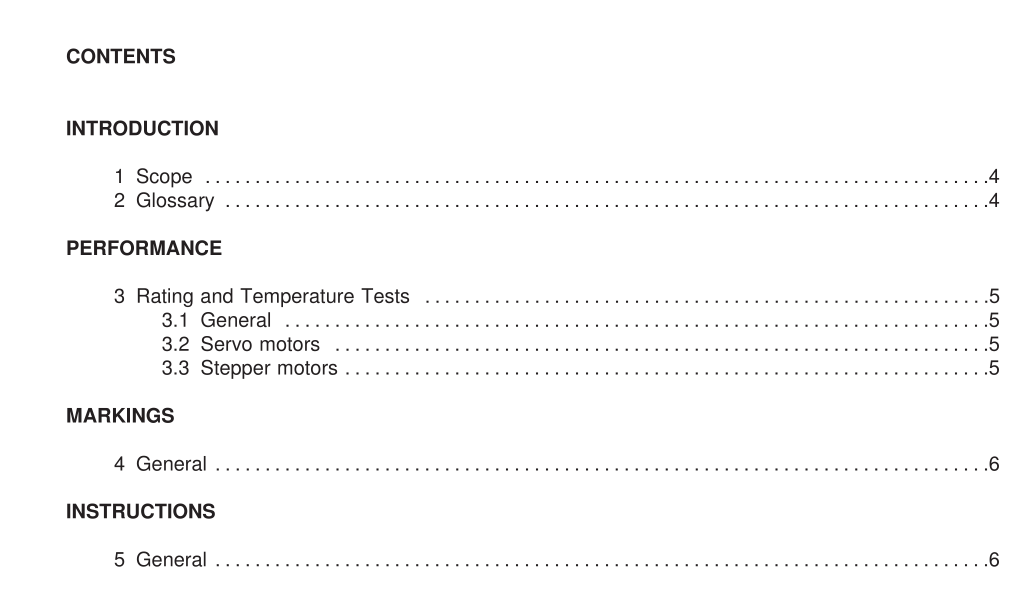UL 1004-6:2012 free download Servo and Stepper Motors
1 Scope
1.1 This Standard is intended to be read together with the Standard for Rotating Electrical Machines -General Requirements,UL 1004-1.The requirements in this Standard supplement or amend therequirements in UL 1004-1.The requirements of UL 1004-1 apply unless modified by this Standard.
1.2 This Standard applies to servo and stepper motors. The requirements in this Standard are intendedto evaluate the suitability of the motor for normal use when fed from an appropriate controller (drive)through its manufacturer declared normal operating region.
1.3 This Standard does not address:
a) The efficacy of motor overtemperature protection under normal or abnormal conditions; norb) The operation of a motor in hazardous (Classified) locations.
2 Glossary
2.1 For the purpose of this standard, the following definitions apply.
2.2 CONTINUOUS STALL CURRENT – A maximum value of current specified by the manufacturerwhich when conducted by the motor windings under stalled (locked-rotor) conditions will not causemotor temperature to exceed its rated temperature rise.
2.3 HOLDING TORQUE -The maximum static torque that can be applied to the shaft of a steppingmotor,excited with rated current,without causing rotation.
2.4 PULLOUT TORQUE -The maximum torque that a stepper motor is capable of delivering at agiven speed before slipping out of synchronization.
2.5 SERVO MOTOR – A motor specially designed and built, having a high speed of response anddesigned for use in a feedback control system, typically for precision positioning.
2.6 SOAC – A curve on a servo motor torquelspeed chart, which defines the limit of the SafeOperating Area for Continuous operation for the given motor.
2.7 STEPPING (STEPPER)MOTOR – An electromagnetic machine designed to convert a series ofinput electrical pulses into a series of discrete mechanical angular movements. When not slewing, themachine maintains a discrete holding position.
3 Rating and Temperature Tests3.1 General
3.1.1 This Section replaces 31.2 and 32.1 in UL 1004-1.3.2 Servo motors
3.2.1 The Rating and Temperature Tests are to be conducted at two points on the SOAC curve:
a) Maximum torque and zero speed; and
b) Maximum torque and maximum speed.
3.2.2 In each case, the motor shall deliver rated torque and speed with the input current not varying fromthe marked input current rating by more than 10 percent,and the temperatures on materials andcomponents shall not exceed the values specified in the “Maximum Temperatures” Table (Table 32.1) ofUL 1004-1.
3.2.3 At the manufacturer’s option,the Rating and Temperature Tests may be repeated to verifyoperation at the two points on the SOAC curve corresponding to supplementary forced cooling and/orheatsinking.
3.3 Stepper motors
3.3.1 The Rating and Temperature Tests are to be conducted at maximum torque and zero speed(holding) in accordance with the manufacturer declared operating performance envelope.
3.3.2 In each case, the motor shall receive maximum-phase excitation at full rated voltage and current.3.3.3 In each case, the motor shall deliver rated torque and speed with the input current not varying fromthe marked input current rating by more than 10 percent,and the temperatures on materials andcomponents shall not exceed the values specified in the “Maximum Temperatures” Table (Table 32.1) ofUL 1004-1. lf the manufacturer’s specifications require the use of a specified heatsink,the specifiedheatsink shall be used in conducting the Rating and Temperature Tests.
UL 1004-6:2012 free download
